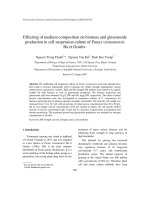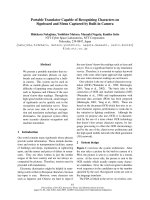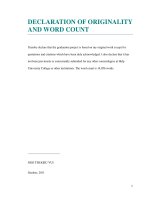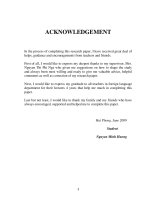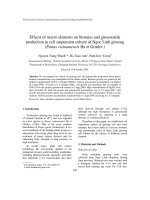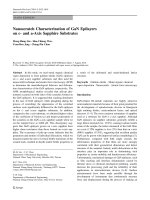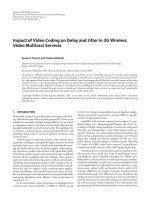Preparation of nanostructured metals on substrates and textile for electrocatalytic and antibacterial applications
Bạn đang xem bản rút gọn của tài liệu. Xem và tải ngay bản đầy đủ của tài liệu tại đây (5.38 MB, 160 trang )
PREPARATION OF NANOSTRUCTURED METALS ON
SUBSTRATES AND TEXTILE FOR
ELECTROCATALYTIC AND ANTIBACTERIAL
APPLICATIONS
CHO SWEE JEN
(B.Eng., Universiti Sains Malaysia, Malaysia)
A THESIS SUBMITTED
FOR THE DEGREE OF DOCTOR OF PHILOSOPHY
DEPARTMENT OF MATERIALS SCIENCE AND
ENGINEERING
NATIONAL UNIVERSITY OF SINGAPORE
2013
DECLARATION
I hereby declare that the thesis is my original work
and it has been written by me in its entirety.
I have duly acknowledged all the sources of
information which have been used in the thesis.
This thesis has also not been submitted for any
degree in any university previously.
_______________________
Cho Swee Jen
8
rd
February 2013
i
Acknowledgements
I would like to express my sincere thanks to all people who helped me, who
walked together with me, who make my life interesting and who developed me into a
better personality throughout my four years in Singapore.
First, greatest thanks to my supervisor; Assistant Professor Ouyang Jianyong for
his continuous guidance throughout these four years. I am really appreciated for his
valuable advices and guidance. I would like to extend my greatest gratitude to Dr.
Karen Siew Ling Chong and Mr. Lee Yeong Yuh for their help in antimicrobial
characterization. I am grateful for giving an opportunity to collaborate with them and
expose myself to bacteria culture processes.
Special thanks to my group members and friends – Dr. Mei Xiaoguang, Neo
Chinyong, Sun Kuan, Dr. Zhang Hongmei, Dr. Zhou Dan, Guiyang, Sherlyn Chua
Shu Er, Tang Chunhua, Li Kangle, Tan Sheng Ming Joel and others from E3A
laboratories. I definitely will not forget the moments we encourage each others, we
laugh together and we outing together. Thanks for decorating my life with these fancy
moments. Also, thanks to Tan Yun Foong Charina for her contribution in preparing
antimicrobial textiles.
Thanks to the laboratory staffs in Department of Materials Science and
Engineering, particularly, Agnes Lim, Serene Chooi, Chen Qun, Henche Kuan, Liew
Yeow Koon, Dr. Zhang Jixuan, Yang Feng Zhen not only for equipment training but
also for sample characterizations.
My perseverance to stand strong until now is from the continuous support given
by my family, especially, my mother and sister – Cho Swee Teng. I am so grateful to
ii
have them in filling up my sorrowfulness with encouragement. I am also deeply
indebted to my husband for his unconditional love and persistent support.
Last but not least, thanks to National University of Singapore, Ministry of
Education, Singapore and Institute of Materials Research and Engineering for their
financial support.
Cho Swee Jen
July 2012, Singapore
iii
Table of Contents
Acknowledgements i
Table of Contents iii
Summary vii
List of Tables ix
List of Figures xi
List of Publications xvii
Chapter 1. Introduction 1
1.1
An overview of nanostructured metals 1
1.2
Properties of nanostructured metals 1
1.2.1
Electronic structure of nanostructured metals 1
1.2.2
Optical properties of nanostructured metals 3
1.3
Preparation of nanostructured metals 8
1.3.1
Nucleation 8
1.3.1.1
Thermodynamic control 10
1.3.1.2
Kinetic control 11
1.3.2
Growth of nanostructured metals 12
Chapter 2. Attachment of Platinum Nanoparticles to Substrates by Coating and
Polyol Reduction of A Platinum Precursor 32
2.1
Introduction 32
2.2
Experimental details 32
2.2.1
Materials 32
2.2.2
Deposition and characterization of Pt nanoparticles 33
2.2.3
Electrochemical catalysis of Pt nanoparticles 33
2.2.4
Deposition of Pt nanoparticles 34
2.2.5
Fabrication and characterization of dye-sensitized solar cells (DSSCs)
with Pt nanoparticles as counter electrode 34
2.3
Results and discussion 36
2.3.1
Characterization of Pt nanoparticles 36
2.3.2
Pt nanoparticles as electrochemical catalyst in methanol oxidation and
DSSCs 43
2.4
Conclusions 49
Chapter 3. Direct deposition of gold nanoplates and porous platinum on
substrates through solvent-free chemical reduction of metal precursors with
ethylene glycol vapor 51
iv
3.1
Introduction 51
3.2
Experimental details 52
3.2.1
Materials and chemicals 52
3.2.2
Deposition of Au nanostructures 52
3.2.3
Deposition of porous Pt 52
3.2.4
Characterization of materials 53
3.3
Results and discussion 53
3.3.1
Deposition and characterization of Au nanoplates 53
3.3.2
Deposition and characterization of porous Pt 62
3.3.3
Mechanism for different morphologies of nanostructured Au and Pt . 68
3.4
Conclusions 70
Chapter 4. Platinum nanoparticles deposited on substrates by solventless
chemical reduction of a platinum precursor with polyol vapor and its application
as highly effective electrocatalyst in dye-sensitized solar cells 71
4.1
Introduction 71
4.2
Experimental details 74
4.2.1
Chemicals and deposition of Pt nanoparticles 74
4.2.2
Characterization of materials and DSSCs 74
4.3
Result and discussion 75
4.3.1
Deposition of Pt nanoparticles through solventless chemical reduction
75
4.3.2
Pt nanoparticles as the counter electrode of DSSCs. 81
4.4
Conclusions 90
Chapter 5. Deposition of Nanometer Truncated Tetrahedron Gold on Graphene
through Chemical Reduction of A Gold Precursor with Ethylene Glycol Vapor 93
5.1
Introduction 93
5.2
Experimental details 93
5.2.1
Materials and chemicals 93
5.2.2
Preparation of rGO films 93
5.2.3
Deposition of nanostructured Au on rGO films 94
5.2.4
Characterization of materials 94
5.3
Results and discussion 96
5.3.1
Characterization of GO and rGO films 96
5.3.2
Characterization of nanostructured Au/rGO composites 101
5.3.3
Effect of acid on the shape of Au nanostructures 107
5.4
Conclusions 109
v
Chapter 6. In Situ Deposition of Ag Nanostructures on Cotton Fabric Through
The Solid-state Reduction of Ag Precursor and Their Antimicrobial Activity . 110
6.1
Introduction 110
6.2
Experimental details 110
6.2.1
Materials and chemicals 110
6.2.2
Preparation of Ag nanostructures on cotton fabric 111
6.2.3
Characterization of Ag/cotton 111
6.2.4
Antimicrobial testing of Ag/cotton 112
6.3
Results and discussion 113
6.3.1
Characterization of Ag/cotton 113
6.3.2
Effect of experimental conditions on the morphology of Ag
nanostructures 117
6.3.3
Antimicrobial testing 120
6.4
Conclusions 122
Chapter 7. Conclusions and future perspectives 123
vi
vii
Summary
Metal nanoparticles with good adhesion to substrates are important in some practical
applications, such as in catalysis and sensors. The deposition of nanoparticles without
capping ligands on substrates is required, such as in catalysis and sensors. Two
methods used to deposit metal nanoparticles without capping ligands through in-situ
chemical reduction of their precursors are presented in this thesis.
The first approach was a two-step method to deposit catalytic platinum (Pt)
nanoparticles with good adhesion to substrates. This first step was to coat a layer of
H
2
PtCl
6
on a substrate. The second step was to cast ethylene glycol (EG) onto the
H
2
PtCl
6
layer and thereafter H
2
PtCl
6
was converted into metallic Pt nanoparticles by
heating at 160
o
C for a few minutes. The Pt nanoparticles merged into a continuous Pt
nanoparticle structure and displayed good adhesion to substrates. This continuous Pt
nanoparticle structures were also used as the counter electrode in the dye-sensitized
solar cells (DSSCs) and exhibited light-to-electricity conversion efficiency of 8.02%
under AM1.5G illumination (100 mW cm
-2
) and good stability.
Although nanostructured Pt could be deposited by the first method, the
deposition was inhomogeneous due to the fluidity of EG. This method was then
modified by using EG vapor to replace the EG solvent in the second step. The
photovoltaic efficiency of DSSCs with Pt counter electrode prepared by the EG vapor
reduction was much higher than that by pyrolysis when the Pt loading was quite low.
Thus, this method could significantly reduce the Pt loading for its application as the
counter electrode of DSSCs.
viii
The method to prepare metal nanoparticles through the chemical reduction of
metal precursors was used to in-situ deposit other nanostructured metals, including
Au, Ag and Pd. In contrast to the 3-dimensional porous structure of porous Pt, the Au
nanostructures appeared as separate triangular nanoplates with the (111) crystal plane
as the basal plane. In the case of Pd, a dendritic structure was formed by the
aggregation of Pd nanoparticles, while Ag appeared as separate islands. The different
morphologies of the nanostructured metals were related to their different surface
energies.
This method was also explored to deposit nanostructured metals on graphene.
The chemical reduction of HAuCl
4
by EG vapor also gave rise to the deposition of
nanometer truncated tetrahedron gold on rGO. The shape and size of the Au
nanostructures could be altered by controlling the Au loading. In addition, the shape
of the metal nanostructures could be manipulated by introducing acids during the
chemical reduction of HAuCl
4
. The acids can decelerate the chemical reduction and
control the kinetics of the growth of the metal atoms.
This method was also explored to in-situ deposit Ag nanoparticles onto textiles
for antibacterial applications. The Ag nanostructures demonstrated good adhesion to
the textiles. They also exhibited excellent antibacterial activities against Escherichia
coli (Gram-negative) and Staphylococus epidermidis (Gram-positive) bacteria, which
are found commonly on the human skin after 1 hour of dynamic contact in aqueous
media.
ix
List of Tables
Table 1.1. Surface energies of some FCC metals [16]. 11
Table 2.1. Photovoltaic Performances of DSSCs with Pt Counter Electrodes Prepared
by the Two-Step Deposition from Different Amounts of H
2
PtCl
6
. 49
Table 4.1. Photovoltaic performances of DSCs with Pt nanoparticles deposited by (a)
EG vapor reduction, (b) pyrolysis, (c) two-step EG solution reduction and (d) one-step
EG solution reduction of H
2
PtCl
6
on FTO glass as the counter electrode. The Pt
loading was constant at 0.39 µg cm
-2
for these four methods. 85
Table 6.1. Antimicrobial activity of Ag coated cotton against Gram-negative, E. coli
(ATCC 25922) and Gram-positive, S. epidermidis (ATCC 12228) bacteria. The viable
bacteria were monitored by counting the number of bacteria colon-forming units
(CFU), N/N
o
is a survival fraction. 122
Table 7.1. Summary of the metal nanostructures morphologies developed by solution
and vapor methods on various substrates. 126
x
xi
List of Figures
Figure 1.1. Schematic drawing of energy band levels for molecules, nanoparticles and
bulk solid. 2
Figure 1.2. Profile of the density state g(E) for different dimensionality [4]. 3
Figure 1.3. Types of (a) Surface plasmon polaritons at metal-dielectric interface and
(b) localized surface plasmons on a metal nanoparticles [6]. 5
Figure 1.4. Calculated UV-vis extinction (black), absorption (red) and scattering
(blue) spectra of silver nanostructures (a) an isotropic sphere, (b) cube, (c) octahedron
and (d) triangular plate [9]. 7
Figure 1.5. Size-related to the changes of Ag nanoparticles [10]. 7
Figure 1.6. UV-extinction spectra of Ag (a) 150-nm and (b) 75-nm bipyramid [11]. 8
Figure 1.7. Illustration of surface energy, γ (green), volume free energy, G
v
(blue) and
overall excess free energy, ∆G
r
(red) [12]. 9
Figure 1.8. Ideal full-shell metal clusters with “magic number” of atoms. [14]. 10
Figure 1.9. Different shapes of FCC metal nanocrystals. The green, orange and purple
colors represent the {100}, {111} and {110} facets, respectively. Twin planes are
delineated with red lines. The parameter R is defined as the ratio between the growth
rates along the <100> and <111> directions [14]. 14
Figure 1.10. Chemical structure of (a) ethylene glycol and (b) diethylene glycol. 16
Figure 1.11. Schematic drawing of the metal particle formation through polyol
synthesis route. 16
Figure 1.12. Schematic drawing of the metal particle formation through the polyol
synthesis route [32]. 18
Figure 1.13. Schematic drawing of Dye-sensitized solar cells (DSSCs) operation. 21
Figure 1.14. Schematic drawing of the fuel cell operation. 24
Figure 1.15. SEM images of (a) Escherichia coli (E. coli) and (b) Staphylococcus
aureus (S. aureus) [49,50]. 25
Figure 2.1. XPS spectra of (a) H
2
PtCl
6
and (b) Pt nanoparticles by reducing H
2
PtCl
6
of 17.0 µgcm
-2
with EG of 9.7 µlcm
-2
at 160
o
C. 37
Figure 2.2. EDX spectrum of Pt nanoparticles deposited on FTO glass by reducing
H
2
PtCl
6
of 17.0 µgcm
-2
with EG of 9.7 µlcm
-2
at 160
o
C. 37
xii
Figure 2.3. SEM images of Pt nanoparticles on FTO glasses with a low
magnification. The Pt nanoparticles were deposited by reducing H
2
PtCl
6
of (a) 21.3
µg cm
-2
, (b) 8.5 µg cm
-2
, and (c) 6.0 µg cm
-2
with EG of 9.7 µg cm
-2
at 160
o
C during
the fabrication. 39
Figure 2.4. SEM images of Pt nanoparticles on FTO glasses with a high
magnification. The Pt nanoparticles were deposited by reducing H
2
PtCl
6
of (a) 21.3
µg cm
-2
, (b) 17.0 µg cm
-2
, (c) 12.8 µg cm
-2
, (d) 8.5 µg cm
-2
, and (e) 6.0 µg cm
-2
with
EG of 9.7 µlcm
-2
at 160
o
C. 40
Figure 2.5. Cross-sectional SEM images of Pt nanoparticles on FTO glasses. The Pt
nanoparticles were deposited by reducing H
2
PtCl
6
of (a) 17.0 µg cm
-2
and (b) 8.5 µg
cm
-2
with an EG of 9.7 µg cm
-2
at 160
o
C. 41
Figure 2.6. SEM images of Pt on FTO glasses with low and high magnifications. Pts
were deposited by pyrolysis of 17.0 (a) and (b), 85.1 (c) and (d), and 425.5 (e) and (f),
µg cm
-2
H
2
PtCl
6
at 400
o
C. 44
Figure 2.7. Cyclic voltammograms of the 1
st
(solid curves) and 100
th
(dashed curves)
potential scans of Pt nanoparticles on FTO glass in an electrolyte of 0.5M CH
3
OH and
0.5 M H
2
SO
4
. The scan rate was 20 mV s
-1
. The Pt nanoparticles were deposited on
FTO glass by reducing H
2
PtCl
6
of 17.0 µg cm
-2
with EG of 9.7 µl cm
-2
at 160
o
C. 45
Figure 2.8. Photocurrent density_voltage curve of a DSSC with Pt nanoparticles on
FTO glass as the counter electrode. The device was characterized underAM1.5
illumination with a mask area of 0.2124 cm
2
. The Pt counter electrode was prepared
by reducing H
2
PtCl
6
of 17.0 µg cm
-2
with EG of 9.7 µg cm
-2
at 160
o
C. 46
Figure 2.9. Variation of the photovoltaic performance parameters of short-circuit
photocurrent density, (Jsc), open circuit voltage (Voc), fill factor (FF), and power
conversion efficiency (PCE) with day for a DSSC with the Pt nanoparticle counter
electrode fabricated by reducing H
2
PtCl
6
of 8.0 µg cm
-2
with EG of 9.7 µl cm
-2
at 160
o
C. 47
Figure 2.10. Nyquist plot of a DSSC with Pt nanoparticles on a FTO glass as the
counter electrode in dark. The device was tested immediately and 30 days after the
device fabrication. The Pt counter electrode was prepared by reducingH
2
PtCl
6
of 17.0
µg cm
-2
with EG of 9.7 µl cm
-2
at 160
o
C. The device was tested immediately after
assembly of the cell. The stability of the device was studied by aging the device in the
dark at room temperature. 48
Figure 3.1. (a) XPS spectrum and (b) XRD pattern of Au nanostructures deposited on
ITO through the chemical reduction of HAuCl
4
with EG vapor at 160
o
C. The XRD
peaks labelled with * are due to the ITO substrate. 54
Figure 3.2. SEM images of (a) Au nanostructures on ITO substrate and (b) bare ITO
substrate (c) TEM image and SAED pattern of a triangular Au nanoplate deposited on
Cu grid through the chemical reduction of HAuCl
4
with EG vapor at 160
o
C 56
xiii
Figure 3.3. Distribution of the edge length of triangular Au nanoplates deposited on
ITO glass. 57
Figure 3.4. SEM images of Au nanostructures deposited on ITO glass substrates with
Au loadings of (a) 78.8, (b) 39.4 and (c) 3.9 µg cm
-2
. 59
Figure 3.5. Dependence of the average edge length of triangular Au nanoplates on the
Au loading. (Inset: Error bar of edge length of triangular Au nanoplates on Au
loading) 60
Figure 3.6. UV-Vis absorption spectra of Au nanostructures deposited on ITO
substrate with Au loadings of (a) 78.8, (b) 39.4 and (c) 7.9 µg cm
-2
. 60
Figure 3.7. SEM images of Au nanostructures deposited on (a) FTO and (b) SiO
2
substrates. The Au loading is 7.9 µg cm
-2
61
Figure 3.8. AFM image and height profile of a triangular Au nanoplate deposited on
Si. 62
Figure 3.9. XPS (a) survey and (b) fine scan spectra of H
2
PtCl
6
and porous Pt. 64
Figure 3.10. (a) EDX and (b) small-angle XRD pattern of porous Pt on FTO glass
deposited through the chemical reduction of H
2
PtCl
6
with EG vapor. 65
Figure 3.11. Surface SEM image of a porous Pt film deposited on FTO glass at 77.7
µg cm
-2
. 66
Figure 3.12. TEM images of porous Pt with (a) normal and (b) high resolution. 66
Figure 3.13. (a) Pd nanostructures and (b) Ag nanostructures deposited on FTO
substrate through EG vapor reduction method. The Pd and Ag loadings are 39.0 µg
cm
-2
. 69
Figure 4.1. (a) Survey XPS spectra of H
2
PtCl
6
and nanostructured Pt deposited by the
EG vapor reduction of H
2
PtCl
6
at 180
o
C. (b) Fine XPS spectrum of nanostructured
Pt. 77
Figure 4.2. SEM images of FTO deposited with nanostructured Pt by (a) the EG
vapor reduction and (b) pyrolysis of H
2
PtCl
6
, (c) two-step EG solution reduction
method, (d) one-step EG solution reduction method and (e) blank FTO. The Pt
loading is 3.89 µg cm
-2
in (a) to (d). 78
Figure 4.3. SEM images of FTO deposited with nanostructured Pt by (a) the EG
vapor reduction and (b) pyrolysis of H
2
PtCl
6
on FTO glass at Pt loading of 0.78 µg
cm
-2
. 80
Figure 4.4. CVs of I
2
/I
3
-
on the Pt work electrodes deposited by pyrolysis (black solid
line), EG vapor reduction of H
2
PtCl
6
(red dash line), two-step EG solution reduction
xiv
method (blue dot line) and one-step EG reduction method (green dash dot line) on
FTO. The area of the working electrodes were kept constant at 1 cm
2
. 82
Figure 4.5. CV curves of Pt electrodes prepared by (a) pyrolysis, (b) EG vapor, (c)
two-step EG solution reduction method and (d) one-step EG solution reduction
method. Dotted lines represent the CV curves after subjecting for 100
th
cycles. 84
Figure 4.6. Current density-voltage characteristics of DSSCs under AM1.5G
illumination. The Pt counter electrodes were fabricated on FTO glass by (a) EG vapor
reduction, (b) pyrolysis, (c) two-step EG solution reduction and (d) one-step EG
solution reduction. The Pt loading was constant at 0.39 µg cm
-2
on FTO glass by these
four methods. 84
Figure 4.7. Nyquist plots of the ac impedances of DSSCs with Pt deposited by (a) EG
vapor reduction and (b) pyrolysis of H
2
PtCl
6
. The Pt loading was 0.39 µg cm
-2
. The
inset is the equivalent circuit. 86
Figure 4.8. Variations of (a) J
sc
, V
oc
and (b) FF, PCE with Pt loading for DSSCs with
the Pt counter electrode deposited by the EG vapor reduction (open circles) and
pyrolysis (solid squares) of H
2
PtCl
6
. 88
Figure 4.9. Variations of R
ct
with Pt loading for DSSCs with the Pt counter electrode
fabricated by EG vapor reduction (open circles) and pyrolysis (solid squares) of
H
2
PtCl
6
. 89
Figure 4.10. Variations of (a) J
sc
, (b) V
oc
, (c) FF and (d) PCE of DSSCs with the Pt
counter electrode deposited by pyrolysis (solid squares) and EG vapor reduction
(open circles). The Pt loading is 0.39 µg cm
-2
. 90
Figure 5.1. Novel preparation method for fabricating r-GO/Au nanostructured
composite film. 95
Figure 5.2. Normalized UV-Vis absorption spectra of GO and rGO films on glass.
The rGO film was prepared by chemically reducing GO with Al in HCl solution. 98
Figure 5.3. XPS spectra of (a) GO and (b) rGO films. 99
Figure 5.4. (a) TEM image of rGO film and (b) SAED pattern of rGO film. 100
Figure 5.5. SEM images of rGO film deposited on glass substrate. 100
Figure 5.6. SEM images of rGO film deposited on glass substrate. 102
Figure 5.7. XRD peak of truncated tetrahedron Au nanostructures deposited on rGO
film reduced at 160
o
C by EG vapor. 102
Figure 5.8. (a) TEM and (b) HRTEM images of truncated tetrahedron Au
nanostructures decorated on rGO sheets. Inset: SAED pattern of truncated tetrahedron
Au nanostructures decorated on rGO sheets 103
xv
Figure 5.9. SEM images of truncated tetrahedron Au nanostructures deposited on
rGO film with Au loading of 7.9 µgcm
-2
at (a) high magnification and (b) low
magnification. 104
Figure 5.10. AFM image of (truncated tetrahedron of Au nanostructure deposited on
rGO film prepared with Au loading of 7.9 µgcm
-2
. 104
Figure 5.11. UV-vis spectra of truncated tetrahedron Au nanostructures deposited on
rGO film with different Au loading at 160
o
C by EG vapor. 106
Figure 5.12. SEM images of four samples illustrating the variation in morphology
when different Au loadings were involved during the synthesis of Au nanostructures
at 160
o
C. Au loading of (a) 78.8 µgcm
-2
, (b) 39.4 µgcm
-2
, (c) 19.7 µgcm
-2
, and (d) 3.9
µgcm
-2
were used 106
Figure 5.13. Influence of HCl concentration on the morphology of Au nanostructures.
SEM images of Au nanostructures were taken from samples prepared with Au loading
of 7.9 µg cm
-2
at 160
o
C with (a) 0.1 M HCl, (b) 0.5 M HCl, (c) 1.0 M HCl and (d) 2.0
M HCl. 108
Figure 5.14. SEM images of Au nanostructures synthesized with 0.5 M of (a) HCl
and (b) LiCl. 109
Figure 6.1. SEM images of (a) blank cotton fabric and (b) cotton fabric attached with
Ag nanoparticles deposited on cotton fabric prepared by solid-state reduction of EG
vapor at 120
o
C. Ag loading is 0.2 mg cm
-2
. 114
Figure 6.2. XPS spectra of (a) AgNO
3
and (b) Ag nanoparticles deposited on cotton
fabric prepared by solid state reduction of EG vapor at 120
o
C. 115
Figure 6.3. XRD peaks of Ag nanoparticles deposited on cotton fabric prepared by
solid state reduction of EG vapor at 120
o
C. 115
Figure 6.4. EDX spectrum of Ag nanostructures deposited on cotton fabric prepared
by solid-state reduction of EG vapor at 120
o
C. 116
Figure 6.5. ICP measurement of different Ag nanostructures leaching out from cotton
fabric. 117
Figure 6.6. SEM images of different Ag loadings (a) 0.1, (b) 0.01 and (c) 0.005 mg
cm
-2
deposited on cotton fabrics. 118
Figure 6.7. SEM images of Ag nanostructures deposited on (a) polyester fabric and
(b) silk fabric through EG vapor reduction at 120
o
C. Ag loading was kept constant at
0.2 mg cm
-2
for both fabrics. 119
Figure 6.8. SEM image of Ag nanostructures deposited on cotton fabric through the
chemical reduction of AgNO
3
by acetaldehyde at room temperature. Ag loading of 0.2
mg cm
-2
was used. 120
xvi
Figure 6.9. Images of E. coli bacteria colonies in (a) “inoculums only” and (b) blank
cotton after dilution to the factor of 10
3
, while petri dish after loaded with Ag loading
of (c) 0.2 mg cm
-2
and (d) 0.1 mg cm
-2
at dilution factor of 10
2
. 121
xvii
List of Publications
[1] Cho SJ, Ouyang JY. Attachment of Platinum Nanoparticles to Substrates by
Coating and Polyol Reduction of a Platinum Precursor. J. Phys. Chem. C, 2011,
115, 8519.
[2] Mei XG, Cho SJ, Fan BH, Ouyang JY. High-Performance Dye-Sensitized Solar
Cells with Gel-Coated Binder-Free Carbon Nanotube Films as Counter
Electrode. Nanotechnology, 2010, 21, 395202.
[3] Cho SJ, Neo CY, Mei XG, Ouyang JY. Platinum Nanoparticles Deposited on
Substrates by A Solventless Chemical Reduction of A Platinum Precursor with
Polyol Vapor and Its Application as Highly Effective Electrocatalyst in Dye-
Sensitized Solar Cells. Electrochim. Acta, 2012, 85, 16.
[4] Cho SJ, Mei XG, Ouyang JY. Direct Deposition of Gold Nanoplates and
Porous Platinum on Substrates through Solvent-free Chemical Reduction of
Metal Precursors with Ethylene Glycol Vapor. Phys. Chem. Chem. Phys., 2012,
14, 15793.
[5] Cho SJ, Suri A, Mei XG, Ouyang JY. In-situ Deposition of Gold
Nanostructures with Well-defined Shapes on Unfunctionalized Reduced
Graphene Oxide through Chemical Reduction of a Dry Gold Precursor with
Ethylene Glycol Vapor. RSC Adv., 2013, 3, 1201.
[6] Cho SJ, Tan CYF, Lee YY, Chong KSL, Ouyang JY. In-situ Attachment of
Antibacterial Silver Nanoparticles on Textiles through the Chemical Reduction
of Solid AgNO
3
with Ethylene Glycol Vapor. Submitted.
Invention Disclosure
[1] Ouyang JY, Cho SJ, Mei XG. New Invention Disclosure; Title: Preparation of
Nanostructured and Porous Metals on Substrates through Chemical Reduction of
Metal Precursors in Solid State. NUS ILO Reference No: 11238N.
1
Chapter 1. Introduction
1.1 An overview of nanostructured metals
Nanostructured metals are metals with at least one dimension ranging between 1 to
100 nm [1]. They can be classified into nanoparticles, nanowires and nanoplates.
They are also characterized by a single-domain crystalline lattice, without the
presence of complicated grain boundaries. In short, nanostructured metals appear as
short range order materials. They have interesting properties significantly different
from bulk materials. The size-dependent properties of nanostructured metals can be
classified into surface phenomena (extrinsic contribution) and quantum confinement
(intrinsic contribution).
1.2 Properties of nanostructured metals
1.2.1 Electronic structure of nanostructured metals
The electronic properties of the nanostructured metals can be deduced in terms of the
electronic properties of the bulk materials. In contrast to the continuous energy band
for the bulk metals, quantum effects cause the continuous band to become discrete
energy levels for metal nanoparticles (Figure 1.1) [2].
2
Figure 1.1. Schematic representation of the energy band levels for molecules,
nanoparticles and bulk solid.
Quantization occurs when the sample size is smaller than de Broglie
wavelength. Since de Broglie wavelength depends on the Fermi energy, Fermi
wavelength λ
F
can be used to justify the existence of the quantum effect in
nanostructured metals. The Fermi wavelength, λ
F
is related to the Fermi energy by the
following equation.
ࣅ
ࡲ
=
ࢎ
ඥ
ࢋ
∗
ࡱ
ࡲ
where h is Planck’s constant, m
e
*
is the effective electron mass and E
F
is the Fermi
energy. The electrons are confined when metal size is less than λ
F
. In general,
nanostructured metals can exhibit quantum confinement when the particles size is
approximately 0.5 – 1 nm [2,3]. The electronic structure also depends on the
dimensionality where the electronic density of states, g(E) for 3-dimension, 2-
3
Figure 1.2. Profile of the density state g(E) for different dimensionality [4].
dimension, 1-dimension and 0-dimension systems are significantly different (Figure
1.2). For 3-D systems, the critical energy, E
j
might correspond to an energy threshold
for the onset of optical transitions. The critical energy is then defined as the energy at
which the collision rate equals the Bremsstrahlung rate. For 2-D systems such as
quantum wells, the E
j
spectrum corresponds to different band edge energy which
arises from the confined states in one given dimension. For the case of 1-D system, E
i
is referred to a van Hove singularity in the density states occurring at each sub-band
edge, where the magnitude of the electronic density of states becomes very large. For
0-D system, the energy levels are completely discrete and thus resemble a molecular
system [4].
1.2.2 Optical properties of nanostructured metals
Metals have unique optical properties compared to other materials. Most bulk metals
appear in silver color, however, copper appears reddish while gold appears in yellow.
This optical manifestation is due to the conduction electrons. The color becomes
black when the diameter of the particles is less than the wavelength of light. This
principle was actually exploited in the ancient techniques to color glass by the

